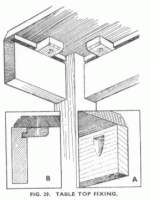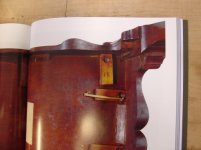Hi Dennis,
Based on your experience, I understand how you might come to feel this way. And, I have used individual mortises to take buttons, myself, but mostly when I forgot to run the groove before assembling the table base - meaning that I could no longer easily run the plough plane along the rails.
But, I think a blanket admonishment not to run grooves is something of an over-reaction. This, because some identifiable factors may have contributed to your experience, and taking them into account while making the table should obviate most/all of them.
For one thing, overtightening of the buttons could unnecessarily stress the rail, setting up this kind of failure. This can be avoided by driving the screw just enough to bring the top in contact with the top edge of the rail, easily accomplished if properly sized to the specific application. Any tighter accomplishes nothing and could tend to restrict the cross-grain movement one is attempting to allow for.
For another, the buttons need to be deep/thick enough that the groove can be some distance from the top edge of the rail to minimize the weakening effect. I don't have hard data on this, but would want to make sure the groove is at least 5/16" from the edge of the rail. In fact, I've tended to "err" in the other direction by using 7/8" stock for the button with a lip to enter a 1/4" groove. This leaves more than 1/2" of material above the groove, which tends to have a good bit of strength.
One can calculate the potential movement of the table top and plough a groove no deeper than necessary, in order to maintain as much strength as possible. If the rails are so thin that even a shallow groove would be problematic, then individual mortised may well be necessary. Though, I guess my inclination in this circumstance might be to think of some other way to affix the table top.
Additionally, more buttons rather than fewer, properly tightened, should tend to spread out any localized stress on the rail.
Finally, I've always been taught that one should never pick up a table, or any type of case work, by its top. Not that I've always followed that advice, but I've ignored it knowing that I'm putting the work at unnecessary risk. Though, having said this, I suspect the failure you experienced was likely due to pre-existing factors.
Don McConnell
Eureka Springs, AR


